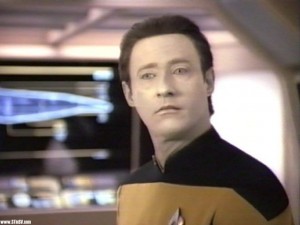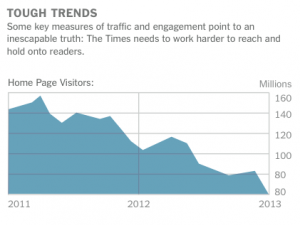I hope that my data will do more than just advance research on health services. My colleagues and I want clinicians, politicians, and citizens to actually use our data in their health care decision making. So how can we best communicate research to them? How do we get our data out of the journals and into the world?
 Most discussions of this topic try to teach researchers how to write accessibly. Don’t lecture; tell a story instead. Engage the reader’s emotions. Be brief, direct, and stop all the scholarly throat clearing. In short, write with the (lay) reader in mind, not Commander Data. Innovate with new media, like Aaron, who is just killing—wait, is that the right metaphor?—with his Healthcare Triage videos.
Most discussions of this topic try to teach researchers how to write accessibly. Don’t lecture; tell a story instead. Engage the reader’s emotions. Be brief, direct, and stop all the scholarly throat clearing. In short, write with the (lay) reader in mind, not Commander Data. Innovate with new media, like Aaron, who is just killing—wait, is that the right metaphor?—with his Healthcare Triage videos.
This is great advice. So far as it goes.
The problem is that you can write wonderfully and still fail to reach your target audience. The New York Times recently evaluated its digital operations and concluded that they are
winning at journalism… Our daily report is deep, broad, smart and engaging — and we’ve got a huge lead over the competition. At the same time, we are falling behind in a second critical area: the art and science of getting our journalism to readers.
That last clause has a deep paradox. Twenty-five years ago, I lived in rural Virginia, right where the paved roads stopped and the dirt roads started. On Sunday mornings, I drove half an hour to a convenience store to get the Times. Now I get it with one tap on my tablet, anywhere. The idea that it is harder now to get journalism to readers seems absurd.
 Nevertheless, the Times is stalled or actually losing readership on several indices. See the fall in visitors to the Times home page just since 2011.
Nevertheless, the Times is stalled or actually losing readership on several indices. See the fall in visitors to the Times home page just since 2011.
What happened is that reading changed. I used to read the Times at breakfast, taking their composite view of the world as the best available summary. In 2014 I inhale heterogeneous chunks of text throughout the day. They aren’t bundled into a package like a newspaper or magazine. I discover some of these texts by searching. Increasingly, I get links through email conversations or Twitter. I may or may not scan the Times, even though it is just a tap away.
So even though I am closer to the Times than I used to be, I am now equally close to a myriad of other great texts. The Times is still worth reading, but now it’s a much smaller proportion of what’s worth reading.
 The Times‘ problem is the same problem health services researchers have when we want to deliver data to the public. Except maybe our problem is harder. Health researchers want to get data into the hands of health decision makers: hospital executives, health care providers, or politicians. These are time-starved people. Torrents of information flow through their organizations, much more than they can process. So decision makers read only a few things that come from outside, in bits of found time, and increasingly on a mobile device. These people won’t search for our content, because searching is agony on a small screen and more importantly, searching competes with the limited time available to read. The upshot is that they won’t discover our needle in the haystack of internet content. To get decision makers to read our stuff, we have to deliver it to them.
The Times‘ problem is the same problem health services researchers have when we want to deliver data to the public. Except maybe our problem is harder. Health researchers want to get data into the hands of health decision makers: hospital executives, health care providers, or politicians. These are time-starved people. Torrents of information flow through their organizations, much more than they can process. So decision makers read only a few things that come from outside, in bits of found time, and increasingly on a mobile device. These people won’t search for our content, because searching is agony on a small screen and more importantly, searching competes with the limited time available to read. The upshot is that they won’t discover our needle in the haystack of internet content. To get decision makers to read our stuff, we have to deliver it to them.
This can be done. Every Friday, AAAS, the publishers of Science Magazine, emails me a curated set of summaries of important new papers, not only in Science but also in other journals. Following these links, I’ve read abstracts and articles in cosmology, molecular biology, etc. that I would never otherwise find. I follow these links because I trust the AAAS. (From the feedback I get, TIE provides this kind of curated summary of health services for many of our readers.)
Scientific organizations should find ways to connect to potential readers, through social media and otherwise, and push the links out. They can make a great start with their own membership, whose interests they can learn through surveys and, perhaps, by capturing pageviews on journal websites. With good tagging of article contents, scientific societies could push algorithmically individualized curated article summaries out to readers.
The best model for scientific communication is not lecturing and it might not be storytelling: It’s conversation. You have to connect, speak, and listen to people who value what you have to say. Then they forward your content to others who trust them.
Reading has changed and that has created an incredible opportunity. Marc Andreessen notes that
the smartphone is the first computer that is packaged up and delivered in the form where everybody [in the world will have] the equivalent of a supercomputer from 20 years ago… in their pocket… And [they] have them all the time. And they are all on the network. They are all connected.
For more TIE writing on communicating science, see Austin, Aaron, me, and definitively, this. And see here for a discussion of the economics of the digital Times, and David Warsh’s critical review of the Times Innovation Report here.
